Single shooter video, run-and-gun setup! A look at my one-man, low footprint, highly mobile interview kit. For when getting fussy just isn’t an option.
Many accepted production niceties had to go out of the nearest window during a recent assignment. Instead, I was faced with the task of simply getting the job done quickly and effectively. My challenge involved the following:
- Filming 25 short marketing videos, totaling just short of an hour.
- Shooting in 21 different locations, scattered across seven different buildings.
- An effective shooting day of circa 4 hours.
- Multiple setup/takedown each day
- Not having any control whatsoever over schedule, locations, or onscreen talent.
- Coronavirus restrictions in place.
- The entire project to be filmed, videos edited, and published to YouTube within two weeks. In addition, I had to build a website in which to embed the videos!
Background
The COVID-19 pandemic has brought with it many restrictions, but also many opportunities. I recently found myself commissioned for a fairly intense assignment as a result. The job involved filming marketing videos for a school Virtual Open Evening. In normal circumstances, secondary schools open their doors to the public each Autumn. This is so prospective students and their parents can get a feel for those schools they will choose between. This year was very different, however. Schools had to find an alternative way to give youngsters and their parents a taste of their offer.
My client school wanted a website with an interactive aerial map of the school site. This would contain HTML hot-spots, each of which called up an embedded YouTube video for each subject. Each subject video featured a talking head from the subject leader. This was interspersed with b-roll footage from lessons, along with stills, and so on. There were also addresses from the Headteacher and Chair of Governors along with testimonials given by students. In addition to producing the videos, I also built the website. Though I say it myself, all in all, it’s a pretty neat solution that proved quite a hit! The results can be seen here.
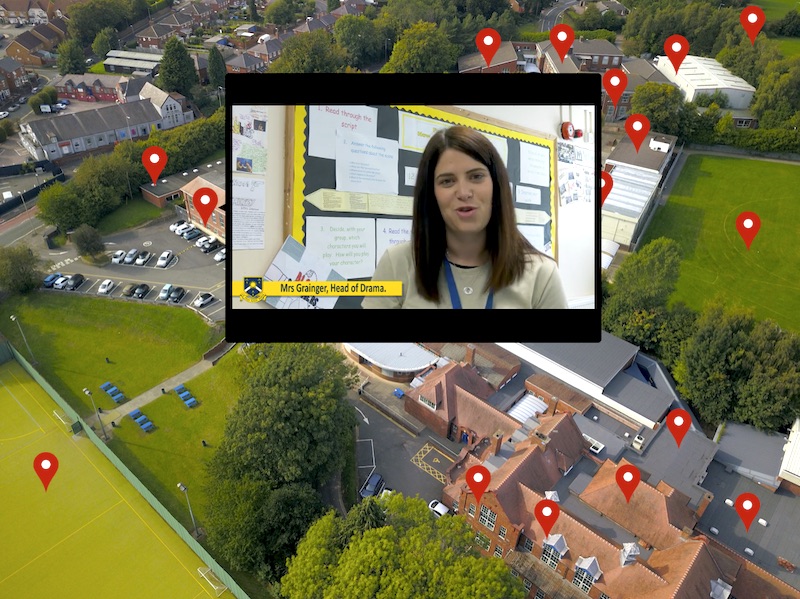
My client school wanted a website with an interactive aerial map, featuring corporate-style video messages.
Context
Before I go any further, I’ll put things into context for those unused to working in schools. Suffice it to say that, even in normal circumstances, schools are extremely busy, highly optimised places. Staff time, vacant rooms, and just about every other resource are in very short supply. Circumstances change with each ring of the lesson bell. This makes coordinating any kind of extraordinary activity a difficult undertaking. However, difficult becomes nightmarish when you add social distancing, segregated bubbles, and staggered lunchtimes to the mix. I think it’s fair to say that at this point, UK schools were functioning on a combination of adrenalin and faith. With many of their established practices completely overturned, they were plunged into uncharted territory. It’s a tribute to school staff that they functioned at all under these conditions.
Learn more about Mooma Media’s services to schools.
My single shooter video challenge begins.
Filming each short movie would be simple in theory. Most of the individual videos were to be somewhere between 90 seconds and three minutes long. Scheduling would have to work around staff and student timetables along with the availability of suitable spaces, however. All of this was made considerably more complex than usual by COVID considerations. In addition, issues surrounding parental permission can be quite restrictive in schools. This meant that I couldn’t simply walk into a room and start filming a lesson for b-roll. As a result, talking heads were filmed on separate occasions to b-roll sequences in most cases.
Working as a single shooter, I had to be very mobile to get myself and my gear around a fairly large site. I also needed to be pretty quick in terms of setup and take-down. The latter was particularly important for filming talking heads. This was because I needed to leave plenty of time for talent coaching, rehearsal, and multiple takes. All of these proved necessary in most cases. Shooting b-roll was straightforward enough, needing just a camera and a tripod. Although I also used a slider on a couple of occasions.
Single shooter video rig – choice of gear and managing it during the project.
Camera.
My camera of choice for most video work these days is a Panasonic AG-CX350 camcorder. OK, this isn’t the kind of camera beloved by those obsessed with shallow depth of field and other ‘cinematic’ capabilities. It is, however, a damned good, self-contained workhorse. This kind of camera is ideal for the ENG/documentary-style workflows involved in the project.
The AG-CX350 produces great image quality and has good, built-in audio capabilities. This negates the need for a separate audio recorder, which adds complexity for single shooter video work. I use this with an Atomos Shinobi 5″ monitor, which I find much clearer than the built-in camera monitor. It also allows camera information to be spread over two screens rather than overcrowding a single monitor. For setup, I just needed to connect a mic cable, fold out the monitors and attach the camera to its tripod. This camera setup was carried around in a simple camcorder bag. The bag also contained spare batteries, a pop-up white balance card, etc.
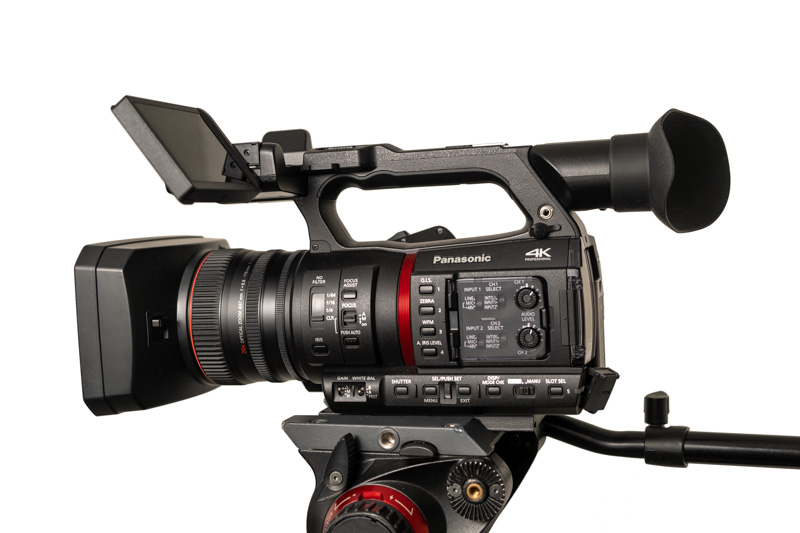
The Panasonic AG-CX350, a great workhorse camcorder.
Run and gun audio……. well not quite.
Shooting talking heads added the complexity of audio to the mix. Voice recordings had to be made with social distancing and COVID hygiene precautions in mind. Therefore, using lav mics, which would need swapping between talent, wasn’t a good option. Instead, I used a Sennheiser MKH50 small-diaphragm condenser mic, held in its custom shock mount. This was mounted at the end of a boom pole. Mic connection was via an XLR cable.
I find using a condenser mic generally gives more natural-sounding results than using a wireless lav mic. However, repeatedly connecting and disconnecting a mic and booming it into position increases workload. Carrying a mic, XLR cable, and boom pole also increases the amount of gear to lug around. By comparison, a lav mic and transmitter fit comfortably into your camera bag or pocket. Meanwhile, the receiver can remain attached to the camera. This means the whole system can remain connected and ready to go all day long. Ideal for a single shooter video production. Having said that, once you have your shot set up, booming a mic into position is quite straightforward. I found I could easily hold the boom-pole fishing rod style while keeping it out of shot. This proved much less fatiguing than holding it overhead. I monitored audio throughout using Sennheiser HD 380 headphones.
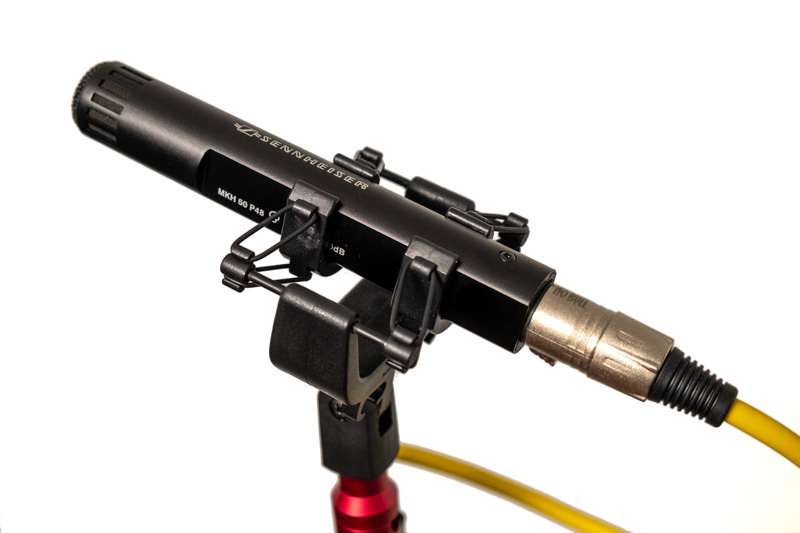
Sennheiser MKH50 small-diaphragm condenser mic, mounted in its custom shock-mount
Tripod.
I used a Manfrotto 504 video head on top of MPRO carbon fiber legs. As a combination, is light enough to be carried around easily, but it’s also versatile. The legs give plenty of height when needed and are easy enough to extend and retract. My only gripe is that the mechanism for locking their angle of spread can be dislodged during setup/takedown. This gives you something else to check regularly.
The 504 head itself is nice and smooth, with variable resistance for both pan and tilt. It also has an adjustable counterbalance for tilting. These features add up to making it really nice to work with. Having a 75mm half ball for leveling the head is also invaluable. Doing this using tripod legs is a complete pain if you’re doing it repeatedly. Leveling with a half ball also means that adjustments can easily be made with the camera in place. Useful if you forget to level the head before attaching the camera. I do wish the 504 had the click-in/out attachment feature of some of the more recent video heads in the Manfrotto range. I find that the slide-in/out mechanism is definitely more awkward to use.
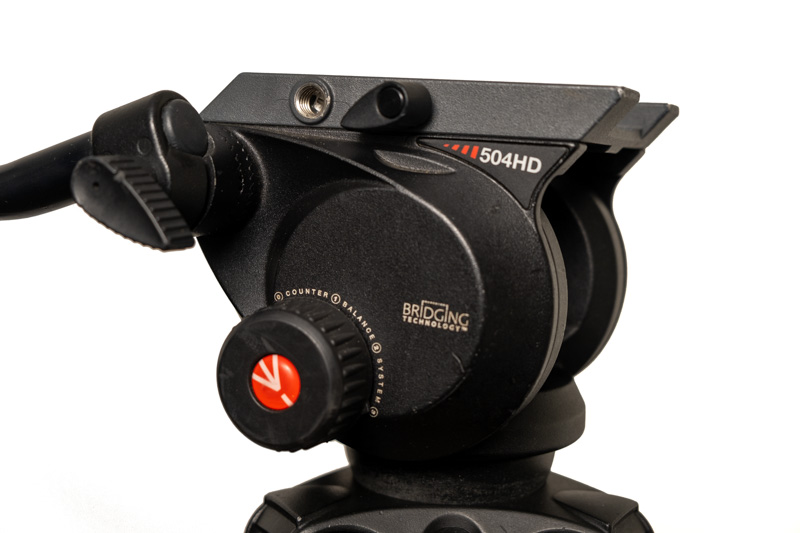
Manfrotto 504 video head.
Single shooter video rig -set up and takedown.
There were really only two bits of setup at each location. First was setting up the camera and tripod. The second was deploying the mic on the end of the boom pole and plugging the mic in. I carried the mic and shock-mount in a padded messenger bag. I also carried my headphones in the same bag and had a bottle of water in one of the side pouches. At the start of the project, I was dutifully wrapping and unwrapping and carrying a 3m XLR cable in the same bag, but I soon resorted to leaving this attached to the boom pole with velcro cable ties in order to save a little time and fuss.
I found that holding the boom pole and tripod together with a couple of fo ball bungees made it easy to carry these in one hand. I had the mic and headphone bag strapped across my body and I carried the camera bag in my other hand. Voila: complete mobile filming set up for single shooter run-and-gun video. O.K. if I hadn’t needed to repeatedly negotiate flights of stairs, I’d have probably used my trusty folding cart. This would have enabled me to carry a few more things light a lighting panel and a reflector. However, as things turned out, this might just have proven more of a hindrance than a help.
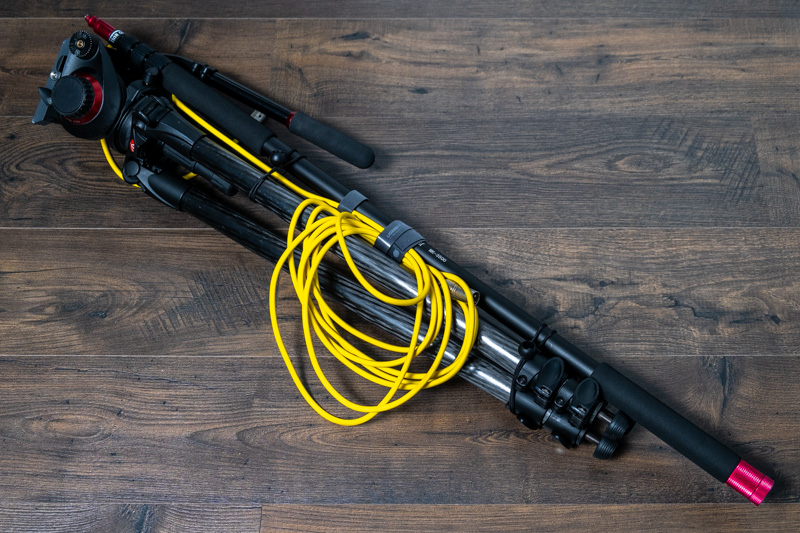
Other gear in my single shooter video setup.
I also used a teleprompter for a few of the longer talking head videos, including both the Headteacher and Chair of Governors’ addresses. While this is time-consuming to set up, it can save a considerable amount of time in the long run. For the longer recordings, I also boomed the mic from a century stand. These filming locations were less busy, so I could leave the c-stand in situ, ready to use at the arranged time.
A teleprompter wouldn’t have suited all of the sessions, as many of the staff preferred to improvise their offering and could perform fluently. This meant that I could get the job done in only two or three takes, which I could then edit together in post. However, there were one or two members of staff who would definitely have benefitted from using a teleprompter. Unfortunately, I had no way of knowing in advance who this might be, and carrying a teleprompter around, just in case, wasn’t an option. Besides, this would have meant preparing a script in advance, which most staff didn’t do. What I would like to have done differently.
Shedding a little light.
Ambient lighting in the school was generally very good, with nicely diffused daylight-balanced LEDs in the majority of rooms. These tended to blend very nicely with incoming window light. In some cases I would have liked to add a little fill light, using an LED panel and softbox. This would have been just enough to lighten up people’s eye sockets and add a catchlight in each eye. However, this would have meant extra hassle and setup time. Besides, a number of my subjects were already nervous about being filmed, so it would have been unwise to make things even more intimidating. Perhaps a small camera-mounted LED panel would have provided the additional lighting I needed. However, I tend to find these a little harsh and unnatural, and they also tend to blind someone looking directly into the camera.
I should have stuck to my guns.
In a couple of cases, staff wanted to feature key wall displays in the frame. Unfortunately, because of height issues, this made framing awkward and close-miking nigh impossible. This resulted in audio capture issues, and in one case some really unpleasant room ambiance is apparent. In hindsight, it would have been far better to stand my ground and argue the case for better framing and mic placement.
Talking head studio.
If I’d had free reign over the style and logistics of the whole project, I would have set up a small studio to film the talking heads. This would have given me much more control over lighting, sound, and background elements. However, the brief was to work on location. Besides, I doubt, under the circumstances, that any room in the school could realistically have been given over exclusively to filming for two or three days.
At the end of the day.
Ultimately, this project was about low disruption, speed of completion, and functionality rather than aesthetics and technical accomplishment. It would have been nice to indulge myself in my craft and in doing so elevate the production values of the project. However, the important thing is that the end result was effective, delivered on time, and within a sensible budget! At the end of the day, the school was very happy and the outcome was as successful as any number of similar projects I’ve seen.
There’s a lot to be said for keeping things simple and having worked like this once, I’d be more than happy to do this type of job again. However, this time I’d be armed with a little more experience of working in these circumstances. If there’s one thing I’ve learned from the experience, it’s that sometimes it’s important to stand your ground. Regardless of how much pressure you’re under to work in a certain way, shortcuts come back to bite you later. While I’m reasonably happy with the results I achieved, I have niggling issues with that room ambiance on one of the videos. However, this is because I know it could have been avoided, rather than because it’s a serious problem for the viewer.
Find out more about my video production services.
Stourbridge-based Mooma Media offers event audio-visual support, event filming, live-streaming, video production, and still photography services to businesses, the public sector, and other non-commercial organisations throughout the Black Country and the wider West Midlands region. To discuss your project, or for a competitive quote click the button below.
Professional filming services in and near:
West Midlands county: Birmingham, Solihull, Sutton Coldfield, West Bromwich, Dudley, Walsall, Wolverhampton.
Staffordshire: Lichfield, Tamworth, Stafford, Cannock,Burton upon Trent.
Shropshire: Telford, Shrewsbury, Bridgnorth, Kidderminster, Ludlow.
Worcestershire: Bromsgrove, Reditch, Droitwich, Worcester,
Warwickshire: Warwick, Stratford upon Avon, Leamington Spa, Coventry, Nuneaton,

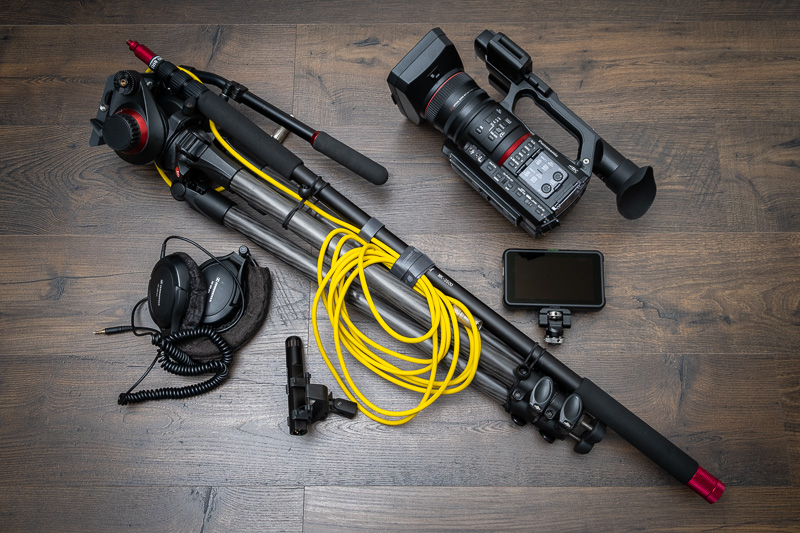
Comments are closed